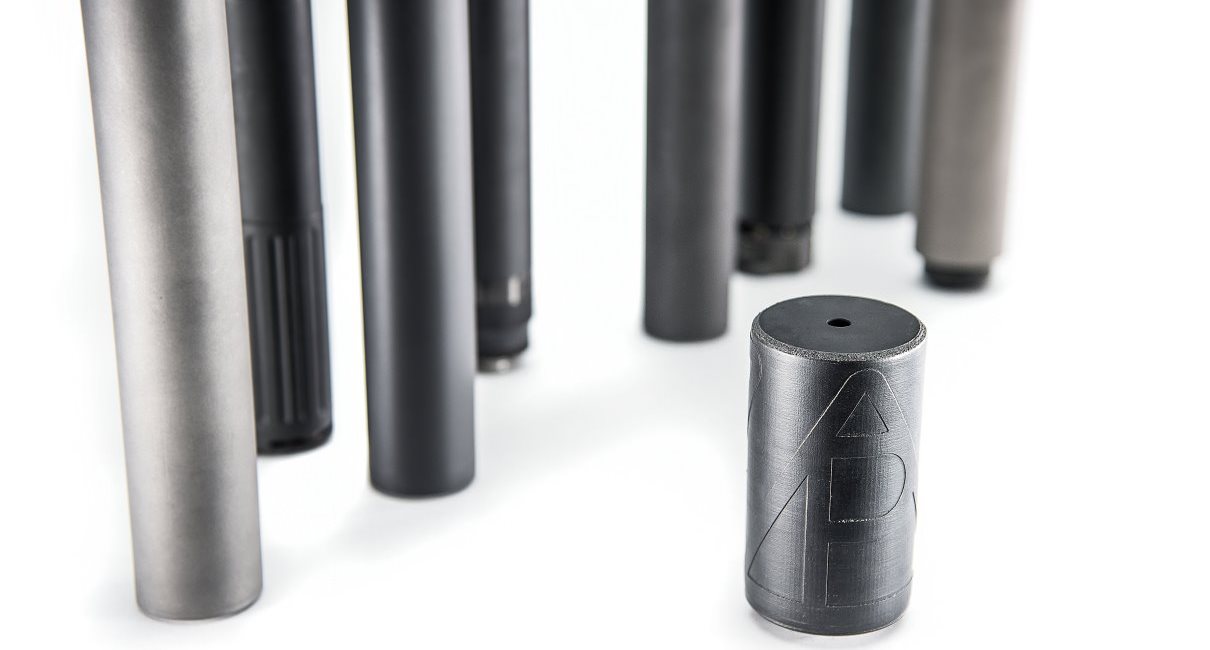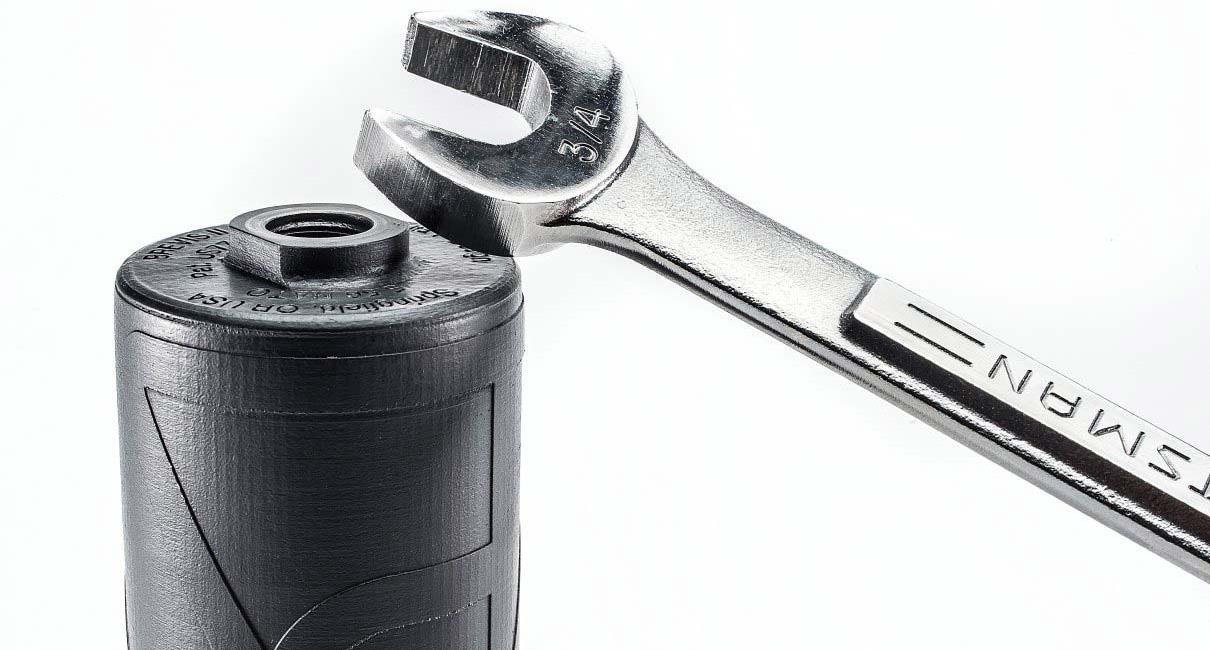Napoleon Complex
By: Sean Utley
 Delta P has rethought the suppressor, focusing on minimal length and size. (Photo courtesy of "Shooting Times")
Delta P has rethought the suppressor, focusing on minimal length and size. (Photo courtesy of "Shooting Times")
Delta P Design's Brevis II gets big performance from a small package
A larger, more diverse pool of manufacturers is beneficial for the suppressor industry. While suppressors are not new, the concept having been created in the early 1900s, many in the industry believe the next great leap in suppressors will come from serious, out-of-the-box design approaches. Traditional thought processes can get stale, stifling potential improvements in product performance.
Waterville, Oregon, is home to Delta P Design. Delta P has been making suppressors since 2006 and has taken an interesting approach to design. It is neither odd nor off the wall, but it is apparent that the company is following its own model. Delta P Design’s products are created for centerfire rifles only, and only one product line is offered, the Brevis II, in multiple calibers.
Delta P Design Brevis II Specs
Caliber: 5.56 NATO
Weight: 11.5 oz.
Overall Length: 3.7 in.
Materials: Hardened Inconel
Noise Rating: 138 dB
Attachment Type: Direct thread only, ½x28
Finish: High-temperature ceramic
MRSP: $1,386
Manufacturer: Delta P Design
What is most obvious about the entire Brevis II line, regardless of caliber, is its reduced overall length. Delta P is designing suppressors that mitigate cantilevered weight. Achieving lighter weight and shorter length decreases the likelihood of negative effects on barrel harmonics and accuracy. The desired goal from the outset was to create a “replacement muzzle device.” Keeping the device as short as possible was imperative. The length of the 5.56 Brevis II is roughly two times that of your average muzzle device. The team at Delta P also wanted to keep the device short so that you can’t detect any difference once it’s attached to the host firearm. Of course, they also wanted their suppressors to be quiet.

(Photo courtesy of “Shooting Times”)
What may not be obvious to the casual observer is the construction. The Brevis II is made from a single piece of material, typically Inconel, through a process that Delta P calls additive manufacturing. With one-piece construction, there are no welds and no components that need to be fit and pressed together inside the suppressor. The result is a stronger device, resistant to cracking and splitting under the extreme pressures generated from rifle ammunition. If barrel-length restrictions are an indicator of a suppressor’s strength, the Brevis’ ability to be mounted to a 7½-inch 5.56mm barrel should be considered impressive, especially when its dimensions are taken into account.
The Brevis II is available in a standard as well as an Ultra version. The Ultra is constructed from what Delta P calls select titanium and high nickel super alloy. Also cut from one piece, the Ultra series is lighter than the standard Brevis and consequently slightly more expensive. The weight difference between the standard 5.56 Brevis II that we reviewed and the Ultra is 4 ounces. This weight difference extends to 6 ounces in the 7.62 versions of the Brevis II. The price difference between the versions is more than $100 for both calibers.
The Brevis II is 3.7 inches in length, which is very short. Its internal volume is made up by its diameter, which is 2 inches. In comparison, the average 5.56 rifle suppressor is 1½ inches in diameter. The Brevis II is shorter and fatter when mounted to a rifle. It should be more maneuverable in smaller confines and more concealable, particularly on a 7½-inch host rifle. The Brevis II weighs 11½ ounces, and the Ultra weighs 7½ ounces.
The concept behind the Brevis II was to design a suppressor with a length and weight within two times that of a standard flash hider. It is a thread-on configuration that some will find attractive, others not. There is much debate about the necessity of quick-attach/detach capability. The Brevis II is meant to stay on the host rifle, and the rifle’s barrel can even be serviced with the Brevis II attached. With a suppressor so short, keeping it attached to your rifle should not be an issue.

Wrench flats will come in handy if you thread the Brevis too tightly, but only if it’s not tucked under a handguard. (Photo courtesy of “Shooting Times”)
Its thread-on configuration will allow for easy transfer from rifle to rifle. Thread pattern is 1/2x28, and the Brevis II has 3/4-inch flats in case a wrench is needed to secure or remove the suppressor. Keep in mind that depending on the rail type, those flats may be inaccessible once the suppressor is secured, because only the thinnest of wrenches will fit between the suppressor and the front end of the rail.
The standard Brevis II is available in 5.56 and 7.62 calibers. The lighter Ultra versions are offered in 5.56, 7.62, 6.5mm and 8.6mm (.338). They are finished in a high-temperature ceramic coating with the option of black or tan. The concept of compact size and light weight carries over to each caliber of the Brevis II, although overall dimensions vary significantly between calibers.
Shooting
Due to the small size of the Brevis and its 7½-inch barrel rating, it made sense to attach it to a short barreled rifle. A Daniel Defense MK18 was chosen for formal testing, although the Brevis was function tested on a number of other 7½-inch SBRs as well, including a DPMS RFA3 and a Noveske Diplomat.
Black Hills 75-grain remanufactured ammunition was used for accuracy testing with the 10.3-inch Daniel Defense. Unsuppressed groups averaged 1.68 inches, with a best group of 1.4 inches. Things improved with the suppressor attached. Point of impact shifted just over an inch at the 1 o’clock position, and average group size went to 1.24 inches, with a best group of 1.08. This is nearly a half-MOA improvement in accuracy performance with the Brevis attached. Results may vary with different ammunition, but most shooters don’t mind getting a half-MOA improvement with their firearm.
In the prone, the blowback wasn’t too bad on the left side of the rifle. If you shoot from the left side of the gun and you add a Brevis to an SBR or other firearm that you’re shooting from the prone, all will be fine since you should technically be positioned further behind the gun. Gas was more noticeable when shooting offhand on that side, but it was not unbearable. Right-handed shooters will have no concerns. The MK18 didn’t appear to run excessively hard while suppressed. This may be due to the blast baffle design, which allows pressures to drop off rapidly once the projectile initially enters the suppressor.
Delta P Design Brevis II Performance
| Daniel Defense MK18 Black Bhills 75-gr. .223 |
Velocity (fps) |
Standard
Deviation |
Extreme Spread |
Av.
Group (in.) |
Best
Group (in.) |
| Unsuppressed |
2,193 |
31 |
78 |
1.68 |
1.4 |
| Suppressed |
2,253 |
46 |
103 |
1.24 |
1.08 |
POI Shift: Yes, 1.5 in. right.
POI Shift Repeatable: Yes
Accuracy results are the average of three five-shot groups at 100 yards. Velocity figures
are derived from a string of 6rounds measured by a chrono 12 feet from the muzzle.
The 7½-inch guns functioned fine but benefited greatly from the addition of Gemtech’s suppressor bolt carrier. This product has never failed to impress and should be a part of your suppressor kit. The shorter guns were worse with gas blowback and tough to bear from the right side. Adding the Gemtech changed that and made shooting enjoyable.
Several people commented on how quiet the Brevis was, especially being that it was attached to short-barreled rifles. Delta P does not list sound ratings for its products because of all the varying factors involved in sound measurement. Though that is the case, Delta P claims that sound reduction in a 14½-inch M4 results in a 138 dB sound level.
Delta P Design has succeeded in making a more compact, yet effective suppressor. You’ll be hard pressed to find many suppressors rated for such short barrels, especially at this size and effective sound suppression. Delta P Design is definitely worth a look.